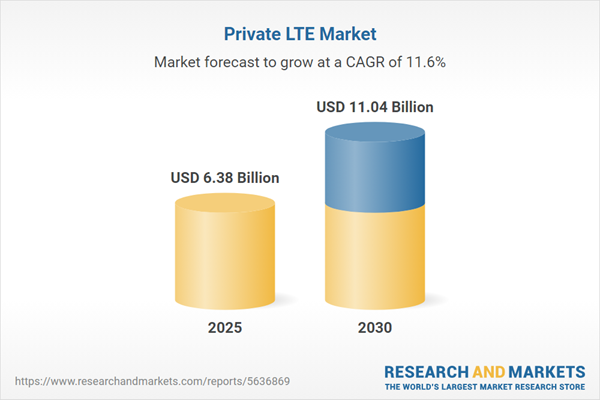Long-Term Evolution (LTE) is a wireless broadband communication standard that enhances UMTS/HSPA and GSM/EDGE protocols, offering improved capacity and speed for data terminals and mobile devices through a redesigned radio interface and core network upgrades. Private LTE networks, unlike public LTE, are dedicated to serving a single organization, such as utilities, factories, or public safety entities, providing exclusive access, customizable coverage, and prioritized connectivity. The private LTE market has experienced significant growth in recent years, driven by technological advancements, the emergence of 5G, and increasing demand for secure, high-performance networks tailored to specific organizational needs.
Market Drivers
The private LTE market is propelled by several key factors, including the transition to 5G, technological innovations, and a competitive industry landscape. Organizations are increasingly adopting private LTE networks due to their extended range, high speed, substantial capacity, and low latency, which address the limitations of traditional PMR/LMR systems. These attributes make private LTE an attractive stepping stone for organizations planning to transition to private 5G networks in the future.Industry Adoption Examples
Teck Resources Limited (October 2020): Shaw Business, in collaboration with Nokia, deployed Western Canada’s first industrial-grade private LTE network for Teck’s Elkview Operations in British Columbia. This 5G-ready network supports Teck’s RACE21TM program, aimed at leveraging technology to enhance mining operations. The network provides improved coverage, reliability, and economic benefits, enabling Teck to optimize its operations.NLMK Group (January 2021): NLMK Group, a leading steel manufacturer, implemented a private LTE/5G network at its Lipstek production site in Russia, with plans to expand to all its facilities. The deployment includes over 50 towers in Lipstek and 40 in Stoilensky, enhancing data transmission speed, information security, and process manageability.
Technological Advancements
The evolution of private LTE services has been transformative. In August 2021, NTT introduced its Private 5G Platform (P5G), the world’s first private 5G/LTE network-as-a-service platform. P5G offers a comprehensive end-to-end solution, enabling enterprises to address business challenges and drive innovation through secure, high-performance connectivity tailored to their needs.Strategic Acquisitions
Market players are also leveraging acquisitions to enhance service offerings and market presence. In December 2021, Kajeet, a provider of wireless connectivity and software solutions, acquired Red Rover Ltd, a broadband network consultancy. This acquisition strengthened Kajeet’s ability to deliver robust private LTE networks, aligning with its goal of promoting digital inclusion across sectors like local governments, schools, and businesses.Geographical Outlook
The Asia-Pacific (APAC) region is poised to dominate the global private LTE market, driven by strategic developments and widespread adoption of advanced technologies. The region’s growth is fueled by increased smartphone penetration, the proliferation of IoT platforms across industries, and targeted initiatives by key market players.Conclusion
The private LTE market is experiencing robust growth, driven by the need for secure, high-performance, and customizable networks. The transition to 5G, coupled with technological advancements like NTT’s P5G platform, is reshaping how private LTE services are delivered. Strategic acquisitions, such as Kajeet’s purchase of Red Rover Ltd, are enhancing service capabilities and market reach. The Asia-Pacific region leads the market, supported by significant investments and collaborations, such as those by Ericsson and Nokia, which are driving the adoption of private LTE and 5G networks. As industries continue to prioritize connectivity and digital transformation, the private LTE market is well-positioned for sustained expansion.Key Benefits of this Report:
- Insightful Analysis: Gain detailed market insights covering major as well as emerging geographical regions, focusing on customer segments, government policies and socio-economic factors, consumer preferences, industry verticals, and other sub-segments.
- Competitive Landscape: Understand the strategic maneuvers employed by key players globally to understand possible market penetration with the correct strategy.
- Market Drivers & Future Trends: Explore the dynamic factors and pivotal market trends and how they will shape future market developments.
- Actionable Recommendations: Utilize the insights to exercise strategic decisions to uncover new business streams and revenues in a dynamic environment.
- Caters to a Wide Audience: Beneficial and cost-effective for startups, research institutions, consultants, SMEs, and large enterprises.
What do businesses use our reports for?
Industry and Market Insights, Opportunity Assessment, Product Demand Forecasting, Market Entry Strategy, Geographical Expansion, Capital Investment Decisions, Regulatory Framework & Implications, New Product Development, Competitive IntelligenceReport Coverage:
- Historical data from 2022 to 2024 & forecast data from 2025 to 2030
- Growth Opportunities, Challenges, Supply Chain Outlook, Regulatory Framework, and Trend Analysis
- Competitive Positioning, Strategies, and Market Share Analysis
- Revenue Growth and Forecast Assessment of segments and regions including countries
- Company Profiling (Strategies, Products, Financial Information, and Key Developments among others).
Key Market Segments
By Technology
- Frequency Division Duplex (FDD)
- Time Division Duplex (TDD)
By Component
- Hardware
- Software
- Services
By End-User Industry
- Aviation
- Oil and Gas
- Manufacturing
- Utilities
- Others
By Geography
- North America
- USA
- Canada
- Mexico
- South America
- Brazil
- Argentina
- Others
- Europe
- Germany
- France
- United Kingdom
- Others
- Middle East and Africa
- Israel
- South Africa
- Others
- Asia Pacific
- China
- Japan
- South Korea
- India
- Others
Table of Contents
Companies Mentioned
- Qualcomm Technologies, Inc.
- Nokia
- Redline Communications
- Ericsson
- Cisco
- Huawei Technologies Co., Ltd.
- NetNumber Inc.
- NEC
- Ambra Solutions inc
- Zeetta Networks Ltd
Table Information
| Report Attribute | Details |
|---|---|
| No. of Pages | 149 |
| Published | June 2025 |
| Forecast Period | 2025 - 2030 |
| Estimated Market Value ( USD | $ 6.38 Billion |
| Forecasted Market Value ( USD | $ 11.04 Billion |
| Compound Annual Growth Rate | 11.5% |
| Regions Covered | Global |
| No. of Companies Mentioned | 10 |









